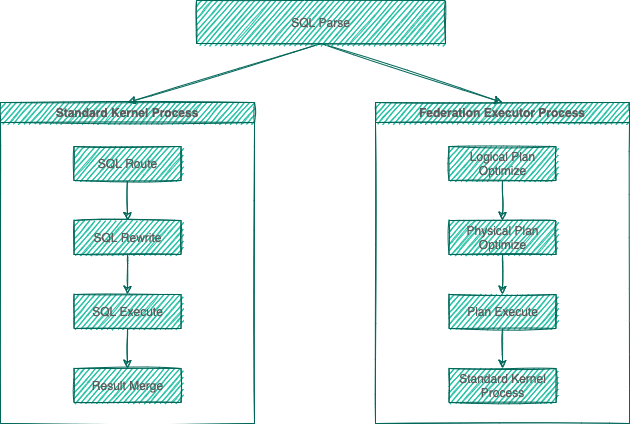The major sharding processes of all the three DBPlusEngine products are identical. According to whether query optimization is performed, they can be divided into standard kernel process and federation executor engine process.
The standard kernel process consists of SQL Parse => SQL Route => SQL Rewrite => SQL Execute => Result Merge, which is used to process SQL execution in standard sharding scenarios.
The federation executor engine process consists of SQL Parse => Logical Plan Optimize => Physical Plan Optimize => Plan Execute => Standard Kernel Process. The federation executor engine perform logical plan optimization and physical plan optimization. In the optimization execution phase, it relies on the standard kernel process to route, rewrite, execute, and merge the optimized logical SQL.

SQL Parsing #
It is divided into lexical parsing and syntactic parsing. The lexical parser will split SQL into inseparable words, and then the syntactic parser will analyze SQL and extract the parsing context, which can include tables, options, ordering items, grouping items, aggregation functions, pagination information, query conditions and placeholders that may be revised.
SQL Route #
It is the sharding strategy that matches users’ configurations according to the parsing context and the route path can be generated. It supports sharding route and broadcast route currently.
SQL Rewrite #
It rewrites SQL as statement that can be rightly executed in the real database, and can be divided into correctness rewrite and optimization rewrite.
SQL Execution #
Through multi-thread executor, it executes asynchronously.
Result Merger #
It merges multiple execution result sets to output through unified JDBC interface. Result merger includes methods as stream merger, memory merger and addition merger using decorator merger.
Query Optimization #
Supported by federation executor engine(under development), optimization is performed on complex query such as join query and subquery. It also supports distributed query across multiple database instances. It uses relational algebra internally to optimize query plan, and then get query result through the best query plan.